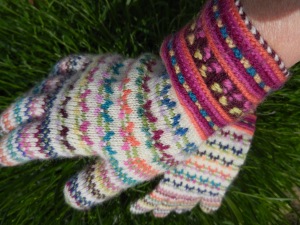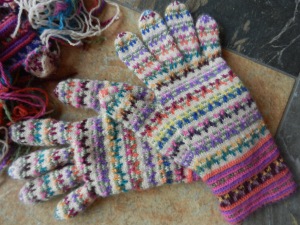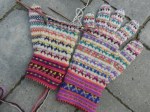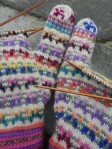A pair of Persian gloves in The Brooklyn Museum show some of the attributes of the Warren Hastings gloves in the Ashmolean, Oxford. The description accompanying the Persian gloves describes the medium of “knitted purl stitch wool”. Knitting traditions are believed to have their roots in the Arabian peninsular and the skill spread as Arabs traded and migrated to different nations. The older Arabic or Eastern style of knitting in the round involved the glove being worked with the wrong side facing outwards using a purl stitch in a style that exactly mirrors or reverses the more familiar knit stitch many of us use today. An increasing number of knitters are re-discovering the Eastern purl, incorporating it into a style of knitting termed combination knitting.
Ahead of a visit to the Ashmolean next month I have experimented with Eastern purl and Western knit along with yarn dominance to see if it is possible to ascertain how these Warren Hastings gloves might have been worked.
The outcome of the experiment baffled me and I doubted myself. Whilst the surface appearance is apparently identical, the tension and gauge is visibly different between the swatches. Mary Thomas’s Knitting book indicates that the Eastern purl produces a tighter squarer fabric than the Western knit. The swatches seem to support this.
Establishing if Warren Hastings gloves are knitted in Eastern purl or Western knit is not going to be easy since there is apparently no obvious difference in the appearance of the stitch where the fabric is undamaged and continuous. I suggest that the only possible way I have of determining the method is by looking at the damaged areas and looking at the orientation of the damaged stitches. Eastern stitches have the leading edge of the stitch at the back of the needle position whereas Western stitches have the leading edge of the stitch at the front of the needle. Priscilla Gibson-Roberts illustrates leading edge of stitches clearly and in much more detail in “Knitting in the Old Way” and “Ethnic Socks and Stockings”. Mary Thomas also illustrates the point well.
How the stranded yarns are carried across the work gives subtle differences to the appearance of the motif. This is termed yarn dominance. Regardless of stitch style and how the yarns are carried, dominance remained the same in the Eastern and Western swatching
By working this test and comparing it to a digital image of Warren Hastings gloves I am currently of the opinion that the gloves have a dominant background colour and the motif colours recede.
Techniques, methods and skills are not uniform to knitting or knitters. Whilst visually I may be able to produce something strongly resembling Warren Hastings gloves, technically they will never be an exact replica for the following reasons:
Firstly, if the gloves turn out to be worked by the Eastern purl method I cannot replicate this at this gauge. Just the swatch took four times longer than the more familiar Western knit method I employ.
Secondly, to best control the stretch of the glove I prefer to run the motif or detail yarns below the background yarn where they are tensioned a little more loosely. This means the motif will be dominant rather than the background.

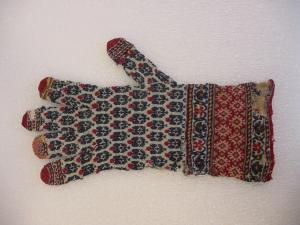
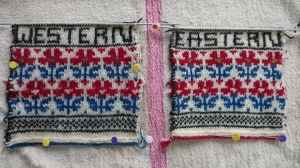




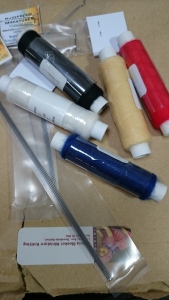



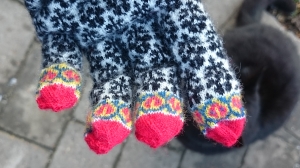


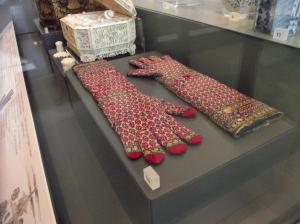 Here is a reminder of where all this is supposed to be going. The only other obstacle is drafting a chart that will work first time. The time spent swatching this most recent pair has been invaluable in giving me a strategy to work my “one hit wonders”. Hopefully the next pair will allow me to resolve and tweak pattern design further.
Here is a reminder of where all this is supposed to be going. The only other obstacle is drafting a chart that will work first time. The time spent swatching this most recent pair has been invaluable in giving me a strategy to work my “one hit wonders”. Hopefully the next pair will allow me to resolve and tweak pattern design further.
